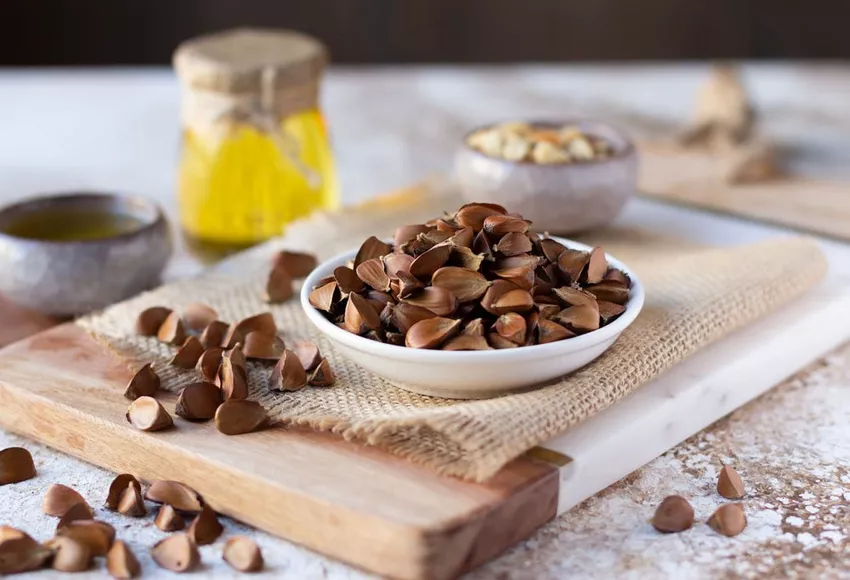
In autumn, nature's baskets are full and children go in search of acorns and chestnuts. These can be used for handicrafts or fed to the animals in the forest. Beechnuts, on the other hand, are usually forgotten on forest and park paths, although the fruits of the beech are extremely tasty and can be used in many ways. In the following, we'll tell you why it's worth not walking past beechnuts carelessly in the future.
What are beechnuts?
The fruits of the common beech are called beechnuts. The small nuts grow to about 1.5 centimeters and sit in pairs in a four-lobed cupula.
To get to the nuts, the rough fruit pods have to be opened. When the fruit capsules fall from the trees, they release their seeds by themselves. In the forests, beechnuts are good food for birds and squirrels, which collect them for the winter and sometimes transport them over long distances.
A rich harvest comes every five to eight years. The forester calls this “full mast”. After dry and hot summers, there is a particularly good chance that numerous nuts can be found and used in a variety of ways from September.
Collect beechnuts
Beechnuts can be found under beech trees from September. However, the trees must be older because the seeds are only produced from an age of 40 to 80 years.
Tip: A dry and hot summer is followed by a good beechnut year. Then there will be a pause for a few years. A bountiful harvest can never be expected twice in a row.
Since beech stands can also be found in parks and near older housing estates, a short walk can be used to stock up on beechnuts.
Are beechnuts he althy?
It can be assumed. Let's take a closer look at the ingredients. First of all, beechnuts have a fat content of about 40 percent. This means we have energy-rich food at our disposal.
Nuts have almost been forgotten today, in the lean years after the war people knew how to appreciate beechnuts. who theFruit rediscovered for itself today, will be enthusiastic about the versatile use and the pleasantly nutty taste.
100 grams of beechnuts contain the following nutrients:
Nutrients
• Fat
• Protein
• Carbohydrates
• Fiber
• Total calories
Quantity per 100 g
• 50g
• 6g
• 30g
• 4g
• 588g
Furthermore, 100 grams of beechnuts contain the following vitamins:
• 3,5500 micrograms of vitamin B3
• 800 micrograms of vitamin B5
• 300 micrograms of vitamin B6
• 500 micrograms of vitamin B1
They also contain a number of minerals and trace elements:
Minerals in mg
• Potassium: 700
• Sulfur: 100
• Sodium: 3
Trace elements in μg
• Zinc: 10,000
• Iron: 7,000
• Copper: 3,000
• Manganese: 2,000
Beechnuts fill the menu of humans and animals
We already mentioned full mast. Wild boars in particular benefit from a rich harvest year. Once upon a time, domestic pigs were also driven into the forest so that they could stuff themselves with beechnuts.
Warning: Not all animals love beechnuts. If horses or dogs eat the nuts, poisoning can result.
We humans have the opportunity to use beechnuts in many ways. Whole seeds can be used as well, and nut flour is a welcome alternative to wheat flour.
It is better not to eat beechnuts raw!
While collecting beechnuts, you should not try the nuts too often. Beechnuts contain a slightly toxic substance called fagin, which can cause stomach pains.
If the beechnuts are roasted, on the other hand, they are free of toxins and generally easily digestible. Roasting also improves flavor and makes it easier to remove the nuts from the shell.
Cleaning and preparing beechnuts properly
After the beechnuts have been collected, they are processed further. Not every capsule fruit will contain the coveted corners. This is easy to find out by filling a bowl with water and placing the seed pods in it. You can discard any fruit capsules that float on the surface. These are too light to contain seeds. The full beechnuts will float to the bottom of the jar and can now be used.
Peeling dry beechnuts is a real feat. Wet nutson the other hand, are much easier to remove from their shells. A small number can be easily opened with fingernails. For larger quantities, using a knife is helpful. First the tip of the capsule fruit is snapped off and then the side shells are removed.
Heat makes beechnuts more digestible
Excessive raw consumption of beechnuts, as already mentioned, should be avoided. The nuts contain prussic acid and fagin.
Warning: Even a few seeds are dangerous for children and dogs.
By warming up, the toxins are broken down. It doesn't matter whether you roast the seeds in a pan, as already mentioned, or pour boiling water over them in a bowl. If you want to make flour, grind the beechnuts in the blender and use them as a baking ingredient.
Eat beechnuts
The roasted seeds taste delicious as an accompaniment to salads. The nutty taste of beechnuts makes them a great addition to a simple dressing made from oil, lemon juice and honey. Roasted beechnuts can also be used as a topping with sunflower seeds or pine nuts.
A pesto recipe can also be modified with beechnuts. You can simply replace the specified amount of nuts or sunflower seeds with beechnuts and get a nutty spread or an addition to the pasta dish.
Recipe idea: beechnut biscuits
Delicious biscuits can be made from beechnut flour.
You need:
• 300 grams wheat flour
• 150 grams beechnut flour
• 120 grams butter
• 3 eggs
• 100 grams sugar
All ingredients are mixed together. The dough is formed into small balls and flattened and placed on a baking sheet. The oven is preheated to 220 degrees. The baking time is eight minutes.